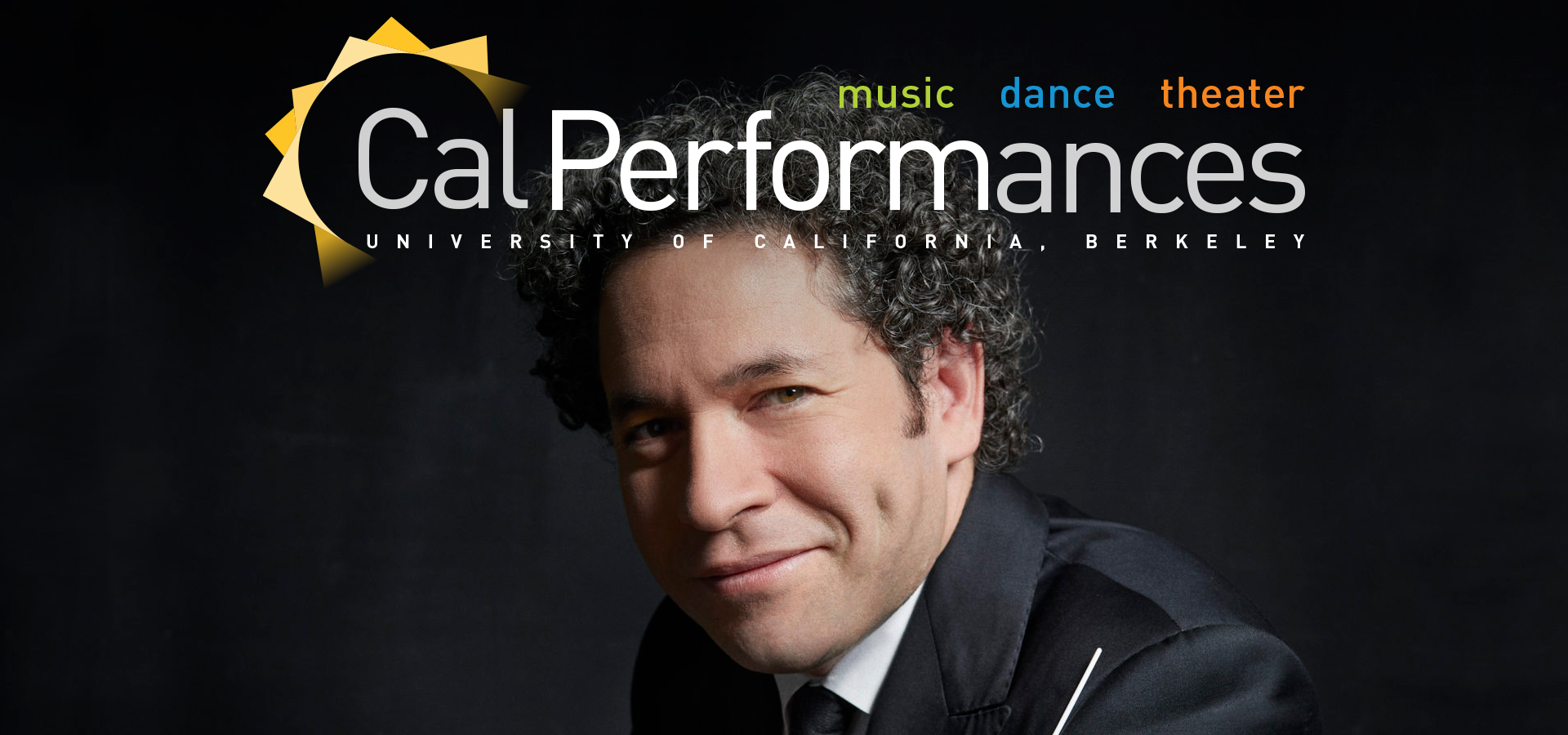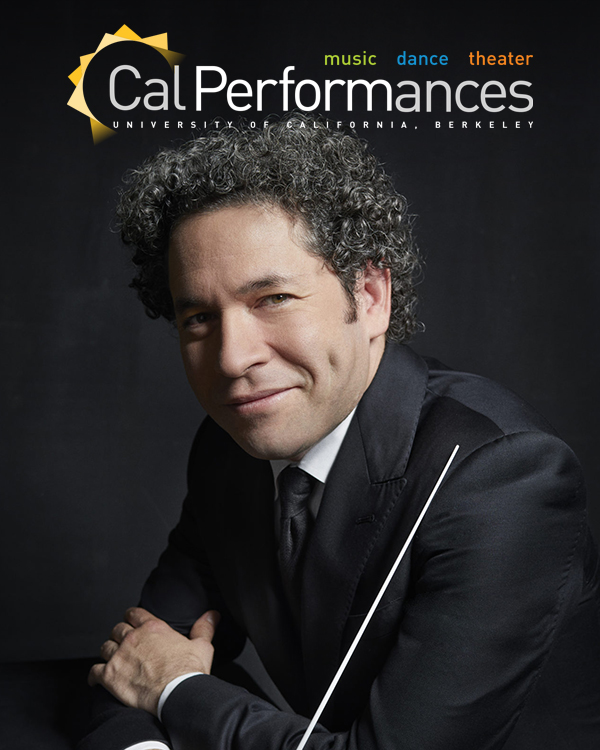The Jan Shrem and Maria Manetti Shrem Great Artist Performance
Gustavo Dudamel conducts
Encuentros Orchestra
with special guest esperanza spalding
Thursday, August 4, 2022, 8pm
William Randolph Hearst Greek Theatre
The Encuentros Festival is generously supported by Judith and Thomas L. Beckmen and the de Marchena-Huyke Foundation.
The taking of photographs and the use of recording equipment during this performance are strictly prohibited.
From the Executive and Artistic Director
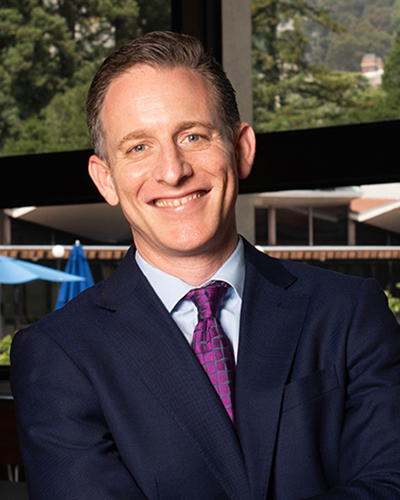
Thank you for joining us! Our programs this summer—the July 28 finale performance for the 2022 Berkeley/Oakland AileyCamp and the grand Greek Theatre concert on August 4 by Maestro Gustavo Dudamel, the Encuentros Orchestra, and special guest esperanza spalding—are superb examples of Cal Performances’ ongoing commitment to arts education and community programs that reach out to people of all ages. Our goal is to respond to the interests and needs of the community by offering a wide variety of enjoyable and accessible opportunities to learn about and participate in the performing arts. Such activities are virtually written into our DNA as an arts presenter and we’re proud to encourage programs like these that involve talented young artists, many of whom are just beginning their careers as performers.
As many of you already know, Cal Performances recently announced details of its upcoming 2022–23 season. Beginning in September, with the brilliant Miami City Ballet and its legendary production of George Balanchine’s iconic Jewels (1967), and continuing into May 2023, with the Bay Area premiere of the powerful folk opera Parable of the Sower, and finally a highly anticipated vocal recital with international dramatic soprano sensation Nina Stemme, it’s a schedule packed with extraordinary opportunities to experience the very best in live music, dance, and theater.
And what a schedule! More than 70 events, with highlights including the return of the legendary Vienna Philharmonic Orchestra under conductor Christian Thielemann (making his Bay Area debut); the beloved Mark Morris Dance Group in Morris’ new The Look of Love: An Evening of Dance to the Music of Burt Bacharach; revered South African artist William Kentridge’s astonishing new SIBYL; a rare Berkeley performance with the San Francisco Symphony and conductor Esa-Pekka Salonen; and a special concert with chamber music superstars pianist Emanuel Ax, violinist Leonidas Kavakos, and cellist Yo-Ma. And these are only a few of the amazing performances that await you!
Illuminations programming next season will take advantage of Cal Performances’ unique positioning as a vital part of one of the world’s top-ranked public research universities. This season, we’ll be engaging communities on and off campus to examine the evolution of tools such as musical instruments, the complex relationships between technology creators and users, the possibilities enabled by technology’s impact on the creative process, and questions raised by the growing role of artificial intelligence in our society.
This concept of “Human and Machine” has never been so pertinent to so many. Particularly over the course of the pandemic, the rapid expansion of technology’s role in improving communication and in helping us emotionally process unforeseen and, at times, extraordinarily difficult events has made a permanent mark on our human history. Throughout time, our reliance on technology to communicate has—for better and worse—influenced how we understand others as well as ourselves. During this Illuminations season, we will investigate how technology has contributed to our capacity for self-expression, as well as the potential dangers it may pose.
Some programs this season will bring joy and delight, and others will inspire reflection and stir debate. We are committed to presenting this wide range of artistic expression on our stages because of our faith in the performing arts’ unparalleled power to promote empathy. And it is because of our audiences’ openness and curiosity that we have the privilege of bringing such thought-provoking, adventurous performances to our campus. The Cal Performances community wants the arts to engage in important conversations, and to bring us all together as we see and feel the world through the experiences of others.
Please make sure to check out our season brochure and our website for complete information about upcoming events. We can’t wait to share all the details with you, in print and online! And don’t forget—single tickets to all 2022–23 performances go on sale on August 9!
Jeremy Geffen
Executive and Artistic Director, Cal Performances
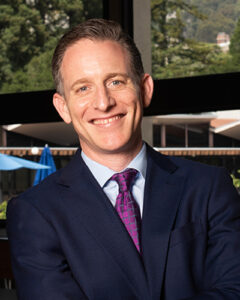 Thank you for joining us! Our programs this summer—the July 28 finale performance for the 2022 Berkeley/Oakland AileyCamp and the grand Greek Theatre concert on August 4 by Maestro Gustavo Dudamel, the Encuentros Orchestra, and special guest esperanza spalding—are superb examples of Cal Performances’ ongoing commitment to arts education and community programs that reach out to people of all ages. Our goal is to respond to the interests and needs of the community by offering a wide variety of enjoyable and accessible opportunities to learn about and participate in the performing arts. Such activities are virtually written into our DNA as an arts presenter and we’re proud to encourage programs like these that involve talented young artists, many of whom are just beginning their careers as performers.
Thank you for joining us! Our programs this summer—the July 28 finale performance for the 2022 Berkeley/Oakland AileyCamp and the grand Greek Theatre concert on August 4 by Maestro Gustavo Dudamel, the Encuentros Orchestra, and special guest esperanza spalding—are superb examples of Cal Performances’ ongoing commitment to arts education and community programs that reach out to people of all ages. Our goal is to respond to the interests and needs of the community by offering a wide variety of enjoyable and accessible opportunities to learn about and participate in the performing arts. Such activities are virtually written into our DNA as an arts presenter and we’re proud to encourage programs like these that involve talented young artists, many of whom are just beginning their careers as performers.
As many of you already know, Cal Performances recently announced details of its upcoming 2022–23 season. Beginning in September, with the brilliant Miami City Ballet and its legendary production of George Balanchine’s iconic Jewels (1967), and continuing into May 2023, with the Bay Area premiere of the powerful folk opera Parable of the Sower, and finally a highly anticipated vocal recital with international dramatic soprano sensation Nina Stemme, it’s a schedule packed with extraordinary opportunities to experience the very best in live music, dance, and theater.
And what a schedule! More than 70 events, with highlights including the return of the legendary Vienna Philharmonic Orchestra under conductor Christian Thielemann (making his Bay Area debut); the beloved Mark Morris Dance Group in Morris’ new The Look of Love: An Evening of Dance to the Music of Burt Bacharach; revered South African artist William Kentridge’s astonishing new SIBYL; a rare Berkeley performance with the San Francisco Symphony and conductor Esa-Pekka Salonen; and a special concert with chamber music superstars pianist Emanuel Ax, violinist Leonidas Kavakos, and cellist Yo-Ma. And these are only a few of the amazing performances that await you!
Illuminations programming next season will take advantage of Cal Performances’ unique positioning as a vital part of one of the world’s top-ranked public research universities. This season, we’ll be engaging communities on and off campus to examine the evolution of tools such as musical instruments, the complex relationships between technology creators and users, the possibilities enabled by technology’s impact on the creative process, and questions raised by the growing role of artificial intelligence in our society.
This concept of “Human and Machine” has never been so pertinent to so many. Particularly over the course of the pandemic, the rapid expansion of technology’s role in improving communication and in helping us emotionally process unforeseen and, at times, extraordinarily difficult events has made a permanent mark on our human history. Throughout time, our reliance on technology to communicate has—for better and worse—influenced how we understand others as well as ourselves. During this Illuminations season, we will investigate how technology has contributed to our capacity for self-expression, as well as the potential dangers it may pose.
Some programs this season will bring joy and delight, and others will inspire reflection and stir debate. We are committed to presenting this wide range of artistic expression on our stages because of our faith in the performing arts’ unparalleled power to promote empathy. And it is because of our audiences’ openness and curiosity that we have the privilege of bringing such thought-provoking, adventurous performances to our campus. The Cal Performances community wants the arts to engage in important conversations, and to bring us all together as we see and feel the world through the experiences of others.
Please make sure to check out our season brochure and our website for complete information about upcoming events. We can’t wait to share all the details with you, in print and online! And don’t forget—single tickets to all 2022–23 performances go on sale on August 9!
Jeremy Geffen
Executive and Artistic Director, Cal Performances
The Jan Shrem and Maria Manetti Shrem
Great Artist Performance
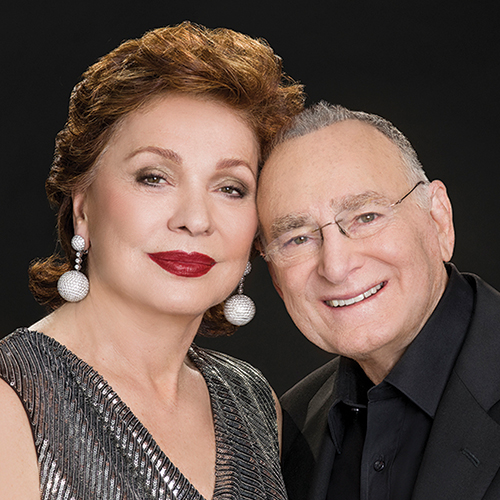
In the 1980s, Maria created one of the most elegant estates in Napa Valley—Villa Mille Rose—where she hosted international artists and celebrities including Luciano Pavarotti, Sophia Loren, Renée Fleming, Plácido Domingo, Nancy Pelosi, Kamala Harris, Gavin Newsom, Isabel Allende, Marchese Piero Antinori, and Andrea Bocelli, to name only a few. As a result, she established herself as the quintessential ambassador of “Made in Italy” creations and Italian lifestyle in the San Francisco Bay Area.
She spends time between the San Francisco Bay Area and Florence and enjoys traveling all over the world while continuing to learn about contemporary art, cultural heritage preservation, and the most refined winemaking brands.
Maria and her husband, Jan Shrem, have long contributed philanthropic support within the fields of education (high schools and colleges), fine arts (museums), performing art centers (operatic and symphonic concert halls), medical research, and nonprofit cultural organizations in the US, Italy, and the UK. The Manetti Shrems currently support more than 30 charities, with favorites in the US including Cal Performances, the San Francisco Opera, the San Francisco Symphony, KQED, Festival Napa Valley, the San Francisco Museum of Modern Art, the Metropolitan Opera in New York City, ArtSmart, SFFilm, Francisco Park (community garden), and UCSF (neurology) and CPMC (cardiology) hospitals. In Europe, Maria is one of the principal benefactors of the Royal Drawing School (established by His Royal Highness, Prince Charles), Friends of the Louvre, Friends of Versailles, the Venetian Heritage, the Italian National Trust (FAI), Palazzo Strozzi Museum Foundation, and the Andrea Bocelli Foundation, with whom she has supported the construction of four new schools, including one at Meyer Children’s Hospital.
The Manetti Shrems—beyond their collection of pieces including works by Picasso, Moore, Burri, and Bacon—are co-founders of the Jan Shrem and Maria Manetti Shrem Museum of Art at UC Davis, which opened its doors on November 13, 2016, realizing a goal that was 60 years in the making. The museum’s collection includes works by major California artists such as Wayne Thiebaud, William T. Wiley, Robert Arneson, Roy De Forest, Ruth Horsting, Manuel Neri, and Roland Petersen. The museum holds 30% of its space for educational and hands-on projects, providing a dedicated area for workshops, like in the Florentine Renaissance tradition of the “Bottega dell’Arte” where artists can learn by doing. The extraordinary architectural design of the museum—which was praised in ARTnews as “One of The World’s 25 Best Museum Buildings of the Past 100 Years,” curated by New York-based architect Florian Idenburg (SO-IL)—has already won 18 awards (six from international organizations); it has also been listed as one of the nation’s top 10 teaching museums.
Maria has received numerous prestigious awards and recognitions as an outstanding and influential cultural ambassador strengthening the relationships between the US and Italy, California and Tuscany, and the San Francisco Bay Area and Florence. In 2019, the President of Italy, Sergio Mattarella, bestowed upon her the title of “Grand Officer of the Order of the Star of Italy.” On March 16, 2022, the mayor of Florence, Dario Nardella, awarded her “The Keys of the City of Florence” as an inspiring role model of patronage following the Renaissance legacy of the Medici family, defining her as “the new Elettrice Palatina”—the latest heiress of the Medici family. On June 22, 2022, Jan Shrem and Maria Manetti Shrem were the inaugural recipients of “The Angels of the Arts Award,” Festival Napa Valley’s highest honor. On the same occasion, the Mayor of San Francisco, London Breed, along with the county and the city, proclaimed June 22, Manetti Shrem Day, dedicated to fostering philanthropy.
About the Program
Giancarlo Castro D’Addona (b. 1980)
Encuentro Obertura Festiva (2022, Bay Area Premiere)
An award-winning composer, conductor, and trumpet player, Giancarlo Castro D’Addona is recognized as one of the most outstanding artists to have emerged from Venezuela’s acclaimed El Sistema music education program. His compositions have been performed in important venues around the world including Carnegie Hall, Walt Disney Concert Hall, Radio France Theater in Paris, Royal Albert Hall in London, and the Konzerthaus in Berlin.
D’Addona’s expertise and versatility have been highly regarded by leading Portland-area music organizations such as the Reed College Orchestra and Encore Brass, who have appointed him as their conductor; and Portland Youth Philharmonic and the Metropolitan Youth Symphony, which have appointed him as the conductor of the Wind Ensemble and the Sinfonietta Orchestra respectively.
Commissioned by the Los Angeles Philharmonic Association and dedicated to the Encuentros Orchestra and Gustavo Dudamel, D’Addona’s Encuentro Obertura Festiva is an energetic work featuring large, vibrant, and euphoric symphonic orchestration. It includes festive fanfares and a melodic theme of a joyful character that is exposed and developed throughout the entire piece in different genres and rhythms to represent not only the Venezuelan roots of the composer, Dudamel, and some Venezuelan members of the orchestra, but also the musical heritage of the members of other countries who comprise this ensemble; in this way, the piece celebrates the cultural diversity that defines the wonderful project of the Encuentros Orchestra.
Antonín Dvořák
Symphony No. 9 in E minor, Op. 95, From the New World
Although he was deeply impressed and influenced by Brahms, Schumann, and Wagner (the latter evident in his Third Symphony), Dvořák created a wholly original style while still conforming to the prevailing musical ethos of his day. His wide appeal is also rightly attributed to his engaging blend of his native land’s earthy musical traditions with traditional symphonic conventions. His gift for melodic invention, along with his sensitive and generous writing for strings (no doubt acquired from years spent as a professional violist), allowed Dvořák to craft works of incredible depth, beauty, and sophistication while communicating his inner emotional world in a thoroughly understandable manner.
His Ninth Symphony was written over a five-month period in 1893 during the composer’s temporary relocation to the United States to head the newly established—yet ultimately doomed—National Conservatory of Music. The symphony, along with the Cello Concerto in B minor and the String Quartet No. 12 (nicknamed American), is one of the handful of works penned by the homesick composer during his final year in America. Echoes and remembrances of Bohemia can be heard all throughout the work, especially through the employment of thematic material suggestive of folk tunes and native melodies. While there are those who insist that there is hardly anything demonstrably “American” about the symphony, it is difficult to deny that Dvořák’s Symphony, presented to the “Old World” from the “New,” was an incredibly important, even essential shot in the arm to the cause of American music; the rapturous reception it received at its Carnegie Hall world premiere with Anton Seidl and the New York Philharmonic would seem to bear this out.
The first movement’s opening section begins with viola and lower strings, offering a nostalgic reminiscence in E minor, punctuated by the horn. The call of the fortissimo strings is answered by horns and woodwinds. The orchestra builds to a climax, then proceeds without delay into the Allegro molto section as the horn introduces the movement’s main theme. The development is unusually brief though melodically rich; the recap and coda are short and sweet.
The second movement contains perhaps the entire symphony’s most loved and recognizable tune, the so-called “Goin’ Home” melody played first by a single English horn. A popular, though sadly mistaken notion is that Dvořák based this movement’s main theme upon some Native American tune or African American spiritual of the day. Dvořák himself repeatedly dismissed the claim, stressing that “I tried only to write in the spirit of those national melodies.”
The third movement scherzo (marked Molto vivace) begins with a very forceful declamation by woodwinds and horn punctuated by strings, timpani, and triangle. The movement’s first theme, a delicate, almost bird-like figure, is underscored by the second violins’ eight bars of undulating eighth notes evocative of a fast-moving river flowing through some dense Bohemian forest. The spirited dance-like nature of this music is intentional: Dvořák was said to be inspired by recollections of the wedding scene from Henry Wadsworth Longfellow’s epic poem Song of Hiawatha.
Just as the horns in the third movement provide a partial glimpse of one of the finale’s principal themes, so too do other key motives from all three preceding movements find their way into the stirring finale.


